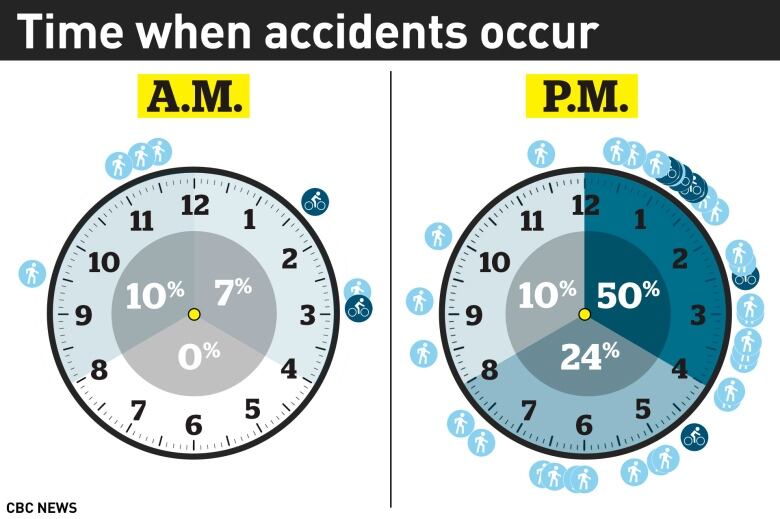Charlottetown pedestrian/bicycle accidents: Where and when they happen
Most of the accidents were preventable, say police
There were 42 accidents where vehicles struck pedestrians or bicycles in Charlottetown in 2015 and 2016.
With 42 accidents spread out over the whole of Charlottetown and around the 24-hour clock, it is difficult to make firm conclusions about any patterns emerging.
But there are some areas, and some times of day, that were more common for accidents in 2015 and 2016.
The most unexpected concentration of events is around early afternoon.

Half of the accidents, 21, occurred in the early afternoon, between noon and 4 p.m. There were no accidents in the early morning, from 4 a.m. to 8 a.m.
Accidents downtown, on major arteries
It is not surprising there were a significant number of accidents, 12, in the downtown area. It is perhaps a little surprising five of these were on Kent Street. The downtown accidents were evenly spread through the day.
The highest number of accidents occurred on major arteries for vehicles, 23 with 11 occurring on Great George/University Avenue alone.
It is here we also see the largest cluster of early afternoon accidents, with 13.
Difficult to know if 42 accidents is a lot
It is difficult to know 42 accidents in two years is a lot or not very many for a city of Charlottetown's size, according to Prof. Ahmed Elgeneidy, of the school of urban planning at McGill University.
"It's about how many people passing at the intersection by car and how many pedestrians," said Elgeneidy.
"You cannot judge the community without knowing flows in the area."
| Charlottetown | 46.3 |
| Halifax | 70.4 |
| Calgary | 30.3 |
Charlottetown deputy police chief Gary McGuigan said his department focuses on individual accidents and their causes.
"Each accident has its own set of reasons," said McGuigan.
"You look at the actual accident and you try to look at the events that led up to the accident in order to determine the best way to prevent these things."
McGuigan said most of the accidents are preventable. He urged motorists, cyclists and pedestrians to be alert.
- MORE P.E.I. NEWS | Living walls, fix-it workshops, and a piano: Charlottetown micro-grant recipients
- MORE P.E.I. NEWS | P.E.I. proposed electoral districts: By the numbers












_(720p).jpg)


 OFFICIAL HD MUSIC VIDEO.jpg)
.jpg)



























































































